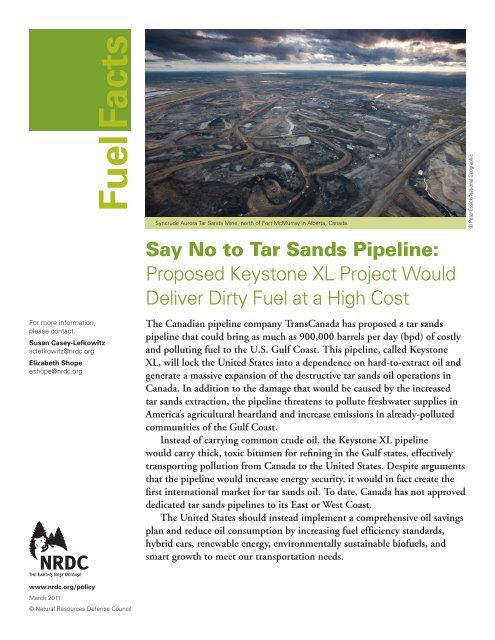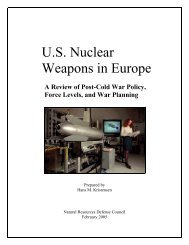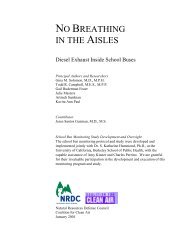Say No to Tar Sands Pipeline - Natural Resources Defense Council
Say No to Tar Sands Pipeline - Natural Resources Defense Council
Say No to Tar Sands Pipeline - Natural Resources Defense Council
You also want an ePaper? Increase the reach of your titles
YUMPU automatically turns print PDFs into web optimized ePapers that Google loves.
Fuel Facts<br />
Syncrude Aurora <strong>Tar</strong> <strong>Sands</strong> Mine, north of Fort McMurray in Alberta, Canada.<br />
© Peter Essick/National Geographic<br />
<strong>Say</strong> <strong>No</strong> <strong>to</strong> <strong>Tar</strong> <strong>Sands</strong> <strong>Pipeline</strong>:<br />
Proposed Keys<strong>to</strong>ne XL Project Would<br />
Deliver Dirty Fuel at a High Cost<br />
For more information,<br />
please contact:<br />
Susan Casey-Lefkowitz<br />
sclefkowitz@nrdc.org<br />
Elizabeth Shope<br />
eshope@nrdc.org<br />
The Canadian pipeline company TransCanada has proposed a tar sands<br />
pipeline that could bring as much as 900,000 barrels per day (bpd) of costly<br />
and polluting fuel <strong>to</strong> the U.S. Gulf Coast. This pipeline, called Keys<strong>to</strong>ne<br />
XL, will lock the United States in<strong>to</strong> a dependence on hard-<strong>to</strong>-extract oil and<br />
generate a massive expansion of the destructive tar sands oil operations in<br />
Canada. In addition <strong>to</strong> the damage that would be caused by the increased<br />
tar sands extraction, the pipeline threatens <strong>to</strong> pollute freshwater supplies in<br />
America’s agricultural heartland and increase emissions in already-polluted<br />
communities of the Gulf Coast.<br />
Instead of carrying common crude oil, the Keys<strong>to</strong>ne XL pipeline<br />
would carry thick, <strong>to</strong>xic bitumen for refining in the Gulf states, effectively<br />
transporting pollution from Canada <strong>to</strong> the United States. Despite arguments<br />
that the pipeline would increase energy security, it would in fact create the<br />
first international market for tar sands oil. To date, Canada has not approved<br />
dedicated tar sands pipelines <strong>to</strong> its East or West Coast.<br />
The United States should instead implement a comprehensive oil savings<br />
plan and reduce oil consumption by increasing fuel efficiency standards,<br />
hybrid cars, renewable energy, environmentally sustainable biofuels, and<br />
smart growth <strong>to</strong> meet our transportation needs.<br />
www.nrdc.org/policy<br />
March 2011<br />
© <strong>Natural</strong> <strong>Resources</strong> <strong>Defense</strong> <strong>Council</strong>
Fuel<br />
Facts<br />
The Keys<strong>to</strong>ne XL <strong>Pipeline</strong> Undermines the United<br />
States Commitment <strong>to</strong> a Clean Energy Economy<br />
To meet an 80 percent reduction in carbon emissions by 2050,<br />
significant changes must occur in our transportation sec<strong>to</strong>r, which<br />
is now responsible for 30 percent of global warming pollution in<br />
the United States. Nearly all of these emissions come from the<br />
combustion of oil. NRDC analysis shows that by 2050, passenger<br />
cars and light trucks—our largest source of transportation<br />
emissions—will need <strong>to</strong> run almost entirely on non-petroleumbased<br />
fuels if we are <strong>to</strong> meet our emissions targets. In contrast,<br />
tar sands produce a heavy crude with a higher lifecycle carbon<br />
content than many other petroleum sources. If the United States<br />
were <strong>to</strong> import 3 million barrels per day (mbd) of tar sands oil, it<br />
could offset all the emissions gains projected by the Environmental<br />
Protection Agency (EPA) under the Renewable Fuels Standard<br />
(RFS2) by 2022. Replacing 3 mbd day of conventional oil with<br />
tar sands oil would be equivalent <strong>to</strong> adding more than 22 million<br />
passenger cars <strong>to</strong> the roads.<br />
Proposed <strong>Pipeline</strong> Presents Serious Environmental<br />
and Health Risks<br />
The Alberta tar sands are found under a region of Boreal forest<br />
and wetlands similar in size <strong>to</strong> Florida. The bitumen—or the<br />
unrefined product excavated from the tar sands—must either<br />
be strip-mined or melted and pumped up after the ground has<br />
been heated with steam for several months. Both forms of tar<br />
sands extraction fragment and destroy the Boreal forest, killing<br />
nesting migra<strong>to</strong>ry birds and many other species. Toxic waste from<br />
the mining operations is s<strong>to</strong>red in vast man-made dams—called<br />
tailings ponds—that already cover sixty-five square miles. <strong>Tar</strong> sands<br />
Proposed Keys<strong>to</strong>ne XL <strong>Pipeline</strong><br />
Length<br />
1,702 miles of new pipeline<br />
Width<br />
36 inches<br />
Capacity<br />
900,000 bpd<br />
Location<br />
Hardisty, Alberta <strong>to</strong> Nederland, Texas<br />
States traversed Montana, South Dakota, Nebraska, Kansas,<br />
Oklahoma, Texas<br />
Cost<br />
$7 billion a<br />
Status<br />
Federal environmental impact assessment process<br />
underway and state-level permitting<br />
processes underway.<br />
Timeline TransCanada aims <strong>to</strong> have pipeline operating in 2012.<br />
Source: TransCanada and U.S. State Department webpages: www.transcanada.com/keys<strong>to</strong>ne/kxl.html<br />
and www.keys<strong>to</strong>nepipeline-xl.state.gov.<br />
a<br />
Cost of Keys<strong>to</strong>ne I pipeline is approximately $5.2 billion so that the <strong>to</strong>tal cost of the entire Keys<strong>to</strong>ne pipeline<br />
project will be over $12 billion. TransCanada Corp. TransCanada, ConocoPhillips <strong>to</strong> Expand Keys<strong>to</strong>ne <strong>to</strong> Gulf<br />
Coast. Downstream Today. July 16, 2008.<br />
extraction uses large amounts of water from the Athabasca River<br />
and underground aquifers and energy—primarily natural gas—<strong>to</strong><br />
heat the water <strong>to</strong> separate the bitumen from the sand.<br />
In September 2010, the Assembly of First Nations called on<br />
the United States <strong>to</strong> take in<strong>to</strong> account in its energy policy the<br />
environmental effects of tar sands extraction on First Nations<br />
peoples, citing among other concerns the high rates of cancer in the<br />
downstream Fort Chipewyan community. 1 These concerns echo the<br />
findings of a report published the month before in the Proceedings<br />
of the National Academy of Sciences, which found that the tar sands<br />
industry releases 13 elements considered priority pollutants under<br />
the U.S. Clean Water Act—including lead, mercury, and arsenic—<br />
in<strong>to</strong> the Athabasca River. 2<br />
Keys<strong>to</strong>ne XL will transport the heavy, corrosive tar sands<br />
bitumen <strong>to</strong> refineries in the United States, crossing America’s<br />
agricultural heartland over water aquifers and rivers. Leaks and<br />
spills are common occurrences from such pipelines. Between 2000<br />
and 2009, pipeline accidents were responsible for 2,794 significant<br />
incidents and 161 fatalities in the United States. 3 In 2010 alone,<br />
Enbridge pipelines spilled over 1 million gallons of oil from<br />
“The tar sands mines are destroying<br />
our environment. We cannot let the<br />
fossil fuel industry do this <strong>to</strong> us.”<br />
Kent Moeckly is a landowner along the<br />
Keys<strong>to</strong>ne <strong>Pipeline</strong>..<br />
Athabasca Delta greenery near Wood Buffalo National Park. This critical migra<strong>to</strong>ry bird habitat,<br />
downstream from the tar sands mines, is at risk due <strong>to</strong> the large amount of water diversions and<br />
<strong>to</strong>xic waste released in close proximity <strong>to</strong> the Athabasca River by tar sands producers.<br />
© David Dodge/The Pembina Institute<br />
PAGE 2 | NRDC <strong>Say</strong> <strong>No</strong> <strong>to</strong> <strong>Tar</strong> <strong>Sands</strong> <strong>Pipeline</strong>: Proposed Keys<strong>to</strong>ne XL Project Would Deliver Dirty Fuel at a High Cost
“Seeing the maps of where this<br />
pipeline goes makes an individual<br />
compare this <strong>to</strong> having open heart<br />
surgery and being left with a scar<br />
for a lifetime.”<br />
David Niemi is a landowner in Buffalo, SD<br />
and the Keys<strong>to</strong>ne XL pipeline crosses his<br />
ranching operation for twelve miles.<br />
Canada’s tar sands in<strong>to</strong> Michigan’s Kalamazoo<br />
River; 275,000 gallons in a suburb of Chicago;<br />
and 126,000 gallons near Neche, <strong>No</strong>rth Dakota.<br />
And within a few months of beginning operation,<br />
TransCanada’s recently completed Keys<strong>to</strong>ne<br />
pipeline had leaked at least three times in South<br />
Dakota. 4 <strong>No</strong>w TransCanada hopes <strong>to</strong> build the<br />
Keys<strong>to</strong>ne XL pipeline over and, in some places, in<br />
the Ogallala Aquifer, which serves as the primary<br />
source of drinking water for millions of Americans<br />
and provides 30 percent of the nation’s ground<br />
water used for irrigation. A pipeline leak would<br />
have devastating effects.<br />
Pollutants from tar sands refineries contribute<br />
<strong>to</strong> a wide range of human health problems,<br />
which include heart and lung disease, asthma,<br />
and cancer. Many of the refineries proposing <strong>to</strong><br />
take tar sands oil are located in areas that already<br />
do not meet air quality standards. <strong>Tar</strong> sands<br />
oil contains more sulfur, nitrogen, and metals<br />
(including lead, nickel, mercury, and arsenic) than<br />
conventional crudes. 5 They also create emissions<br />
of sulfur dioxide (SO 2<br />
) and nitrous oxide (NOx),<br />
which contribute <strong>to</strong> acid rain. In addition, the<br />
tar sands refining process stresses water resources,<br />
demanding vast amounts of fresh water, and<br />
producing ammonia and sludge. In fact, in a<br />
controversial plan, BP proposed <strong>to</strong> increase its<br />
ammonia discharges in<strong>to</strong> the Great Lakes as a<br />
result of its tar sands processing. 6<br />
Alberta<br />
Edmon<strong>to</strong>n<br />
Idaho<br />
Utah<br />
Arizona<br />
Calgary<br />
Helena<br />
Hardisty<br />
Missouri River<br />
Montana<br />
Yellows<strong>to</strong>ne River<br />
Wyoming<br />
Fort McMurray<br />
Colorado<br />
New Mexico<br />
<strong>Tar</strong> <strong>Sands</strong> Region<br />
Keys<strong>to</strong>ne <strong>Pipeline</strong><br />
Proposed Keys<strong>to</strong>ne<br />
XL <strong>Pipeline</strong><br />
Enbridge <strong>Pipeline</strong>s<br />
Saskatchewan<br />
Regina<br />
<strong>No</strong>rth Dakota<br />
South Dakota<br />
Nebraska<br />
Bismarck<br />
Pierre<br />
Ogallala Aquifer<br />
Steele City<br />
Kansas<br />
Oklahoma City<br />
Oklahoma<br />
Red River<br />
Texas<br />
Austin<br />
Mani<strong>to</strong>ba<br />
Hous<strong>to</strong>n<br />
Winnipeg<br />
Saint Paul<br />
Lincoln<br />
Topeka<br />
Neches River<br />
Minnesota<br />
Cushing<br />
Iowa<br />
Superior<br />
Mississippi River<br />
Missouri<br />
Port Arthur<br />
Hudson Bay<br />
Lake Superior<br />
Chicago<br />
Michigan<br />
Lake<br />
Michigan<br />
Kalamazoo<br />
River<br />
Lake Huron<br />
Indiana Ohio<br />
Illinois<br />
Springfield<br />
Pa<strong>to</strong>ka<br />
St. Louis Wood River<br />
Kentucky<br />
Arkansas<br />
Louisiana<br />
Wisconsin<br />
Ontario<br />
Mississippi<br />
Tennessee<br />
Alabama<br />
Florida<br />
Lake<br />
Erie<br />
Georgia<br />
Lake<br />
Ontario<br />
An Investment in a Pipe That May Never<br />
Be Filled<br />
In 2009, the United States imported approximately 950,000<br />
bpd of tar sands oil from the <strong>to</strong>tal 1.5 mbd produced in Canada;<br />
Canada consumes most of the rest. TransCanada’s Keys<strong>to</strong>ne XL<br />
pipeline would be the third new dedicated tar sands pipeline built<br />
from Alberta in<strong>to</strong> the United States in recent years. In 2008, the<br />
U.S. Department of State approved the presidential permit for<br />
TransCanada’s Keys<strong>to</strong>ne pipeline, which will bring 591,000 bpd<br />
of bitumen from Alberta <strong>to</strong> Illinois and Oklahoma. And in 2009,<br />
the U.S. Department of State approved Enbridge’s Alberta Clipper<br />
pipeline, which will have an ultimate capacity of up <strong>to</strong> 800,000 bpd<br />
for delivering bitumen <strong>to</strong> Wisconsin.<br />
Reaching the tar sands production necessary <strong>to</strong> fill these<br />
pipelines in the near future is unrealistic. With over 2 mbd of tar<br />
sands pipeline capacity already existing, Keys<strong>to</strong>ne XL would increase<br />
this <strong>to</strong> over 3 mbd. Assuming Canada’s consumption of the tar<br />
sands stays constant, even industry estimates indicate that these<br />
pipelines could not be filled <strong>to</strong> capacity until 2025—and because of<br />
the structure of pipeline shipping fees, operating these pipelines well<br />
under capacity increases the cost of the oil shipped through them.<br />
PAGE 3 | NRDC <strong>Say</strong> <strong>No</strong> <strong>to</strong> <strong>Tar</strong> <strong>Sands</strong> <strong>Pipeline</strong>: Proposed Keys<strong>to</strong>ne XL Project Would Deliver Dirty Fuel at a High Cost
Fuel<br />
Facts<br />
Measures <strong>to</strong> Reduce Oil Use with Existing Technologies a 2020 2030<br />
Efficiency<br />
Includes new passenger vehicle and truck efficiency; fuel efficient tires and oil for<br />
existing car and aerodynamic retrofits for existing truck fleets; and improvements<br />
in aviation, rail, marine shipping, and oil-heated building efficiency.<br />
Includes smart growth, walkable communities and more transit <strong>to</strong> avoid car trips,<br />
and more efficient operations with some shifts <strong>to</strong> rail <strong>to</strong> reduce freight truck<br />
miles.<br />
Includes transitioning <strong>to</strong> plug-in hybrid and electric passenger vehicles and<br />
increased natural gas use in freight trucks. Biofuels are included in the baseline<br />
and are therefore excluded here.<br />
1.1<br />
4.6<br />
Reduced Driving<br />
1.0<br />
1.5<br />
Cleaner Fuels<br />
0.2<br />
0.9<br />
Total<br />
2.3<br />
7.0<br />
a<br />
NRDC analysis. Oil savings are in comparison <strong>to</strong> a baseline that includes GHG and CAFE standards for light-duty vehicles for model years 2012-2016 as modeled by NRDC and biofuels volumes <strong>to</strong> meet the Renewable Fuels<br />
Standard 2, as projected by EIA’s AEO 2010. This means that these savings are in addition <strong>to</strong> what we will save with GHG and CAFE standards and the RFS2.<br />
The Keys<strong>to</strong>ne XL <strong>Pipeline</strong> Is <strong>No</strong>t in the National<br />
Interest and Should <strong>No</strong>t Be Approved<br />
As required for transnational-boundary pipelines, TransCanada has<br />
applied <strong>to</strong> the U.S. Department of State for a presidential permit for<br />
Keys<strong>to</strong>ne XL. 7 To receive the permit, a number of federal, state, and<br />
local requirements must be met and the U.S. Department of State<br />
must decide that construction and operation of the pipeline is in<br />
the national interest—a process that does not have clear criteria or<br />
transparency.<br />
Any determination of national interest should consider the<br />
full harmful scope of tar sands oil imports in<strong>to</strong> the United States<br />
and the associated negative impacts from extraction, pipelines,<br />
refineries, and end use. By this standard, the Keys<strong>to</strong>ne XL pipeline<br />
falls far short, and the Department of State’s analysis of these issues<br />
was seriously lacking in its April 2010 draft environmental impact<br />
statement. 8<br />
<strong>Tar</strong> sands require oil prices <strong>to</strong> be high <strong>to</strong> turn a profit. It is not<br />
in the national interest <strong>to</strong> lock the United States in<strong>to</strong> supporting<br />
an expensive and dirty form of oil for many years <strong>to</strong> come. Also,<br />
additional capacity for tar sands oil perpetuates America’s addiction<br />
<strong>to</strong> oil, and undermines the clean energy alternatives that would<br />
bring genuine energy security.<br />
Oil use in the United States has stabilized, and NRDC analysis<br />
has shown that the nation is on the path <strong>to</strong> implementing oil saving<br />
policies that could reduce our oil consumption by 2.3 mbd by<br />
2020 and 7 mbd by 2030, compared <strong>to</strong> the Energy Information<br />
Administration’s business as usual projections—and all with<br />
existing technology. Scaling up these technologies even further<br />
and putting American ingenuity <strong>to</strong> use, the United States now has<br />
the opportunity <strong>to</strong> strive <strong>to</strong> eliminate fossil fuel use al<strong>to</strong>gether by<br />
2050. The policies <strong>to</strong> support this goal include support for higher<br />
efficiency new cars, improved fuel economy standards, advanced<br />
environmentally sustainable biofuels, smart growth and transit,<br />
electric vehicles and air travel improvements, and increased research<br />
and development.<br />
<strong>Tar</strong> sands oil threatens our air, water, land, and economy, and<br />
will increase already dangerously high greenhouse gas emissions<br />
and demand for natural gas. <strong>Tar</strong> sands oil has no place in the clean<br />
energy economy.<br />
1<br />
The Pembina Institute, Canadian Aboriginal Concerns with Oil <strong>Sands</strong>: A compilation of key issues, resolutions, and legal activities, (September 2010). http://pubs.pembina.org/reports/briefingnoteosfn<strong>to</strong>ursep10.pdf.<br />
2<br />
David W. Schindler et. al, “Oil <strong>Sands</strong> Development Contributes Elements Toxic at Low Concentrations <strong>to</strong> the Athabasca River and its Tributaries,” Proceedings of the National Academy of Sciences vol. 107, no. 37, (August 30,<br />
2010), 16178-16183, http://www.pnas.org/content/107/37/16178.full.pdf.<br />
3<br />
<strong>Pipeline</strong> Hazardous Materials and Safety Administration. Significant <strong>Pipeline</strong> Incidents. http://primis.phmsa.dot.gov/comm/reports/safety/SigPSI.html?nocache=6758#_all.<br />
4<br />
Leaks in the Keys<strong>to</strong>ne pipeline have been reported <strong>to</strong> the South Dakota Department of Environment and <strong>Natural</strong> <strong>Resources</strong> (DENR) on May 21, June 23 and August 10, 2010, South Dakota DENR. South Dakota Environmental<br />
Events Database. http://denr.sd.gov/des/gw/Spills/SpillData.aspx<br />
5<br />
Declaration of Galen W. Hartman, “<strong>Natural</strong> <strong>Resources</strong> <strong>Defense</strong> <strong>Council</strong>, Inc. v. United States Department of State et al. and TransCanada Keys<strong>to</strong>ne <strong>Pipeline</strong>,” United States District Court for the District of Columbia, Civil Action<br />
<strong>No</strong>. 08-1363 (RJL), Document 22-3, (Filed 10/17/2008), 4.<br />
6<br />
ADVENT-ENVIRON, Addendum <strong>to</strong> “Case-by-Case Antidegradation Analysis” Prepared for BP Whiting, Indiana, submitted <strong>to</strong> IDEM <strong>No</strong>vember 30, 2006, (Dec. 12, 2006), 3.<br />
7<br />
Executive Order 13337 of April 30, 2004, which amends Executive Order 11423 of August 16, 1968.<br />
8<br />
In comments on the DEIS, the EPA labeled it “Category 3: Inadequate” and requested significantly more analysis in a revised DEIS. http://yosemite.epa.gov/oeca/webeis.nsf/%28PDFView%29/20100126/$file/20100126.<br />
PDF?OpenElement.<br />
www.nrdc.org/policy © <strong>Natural</strong> <strong>Resources</strong> <strong>Defense</strong> <strong>Council</strong> March 2011 Printed on recycled paper
















